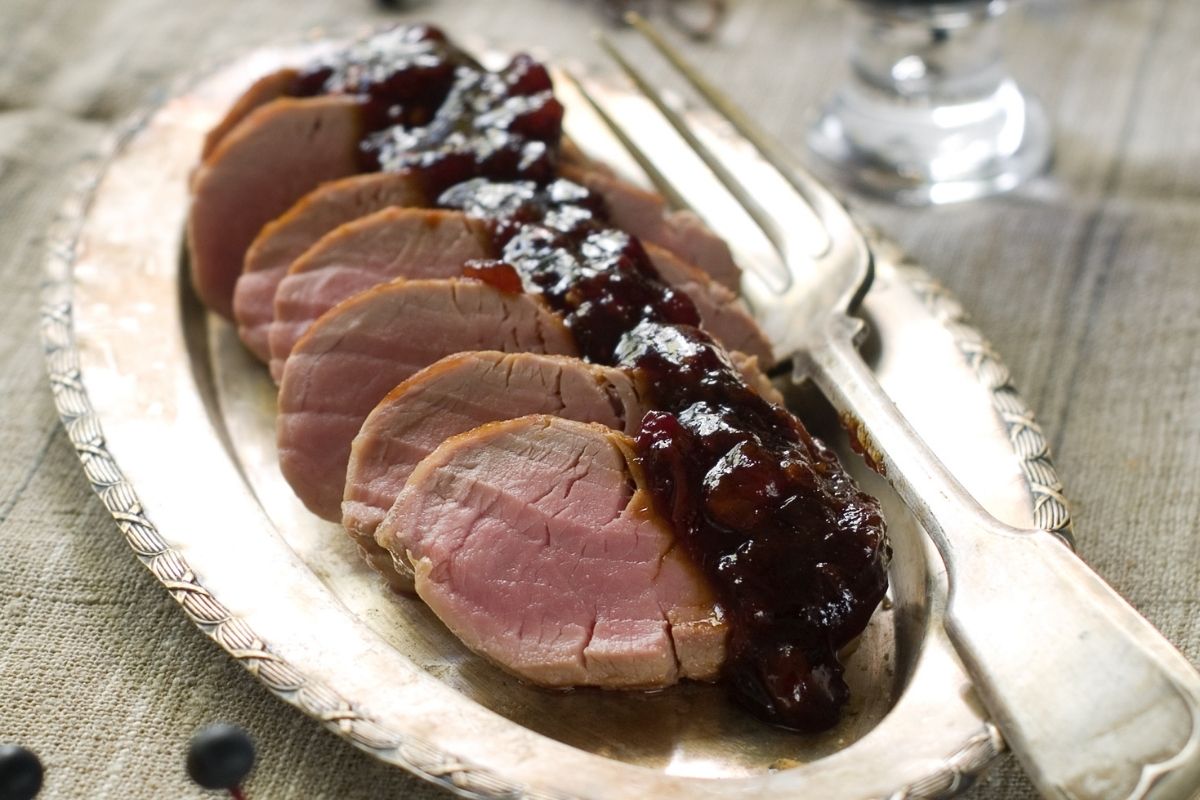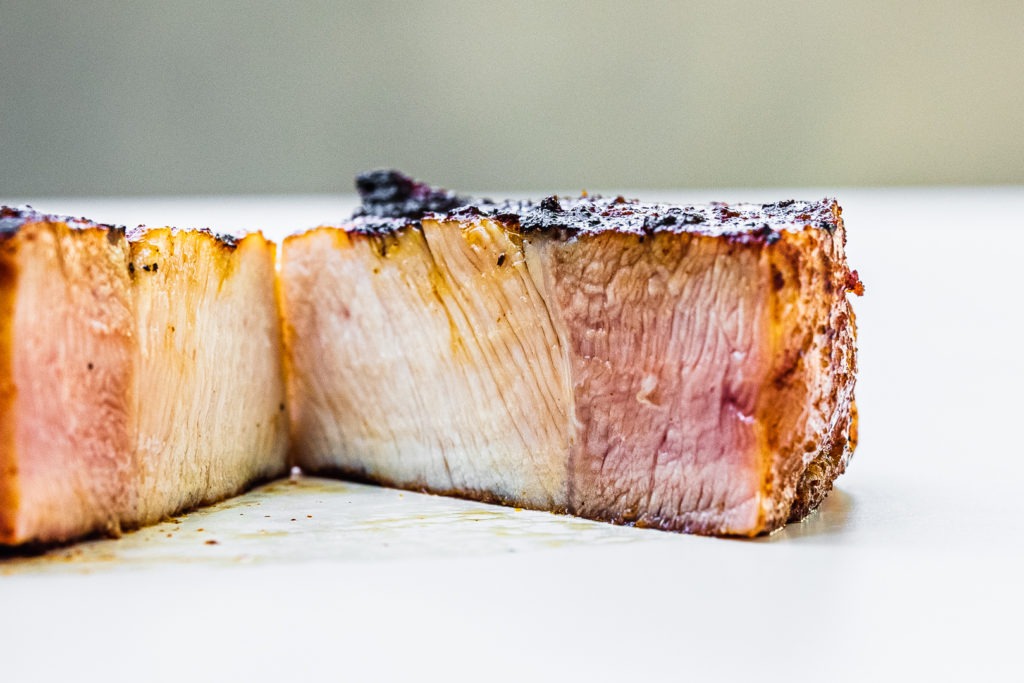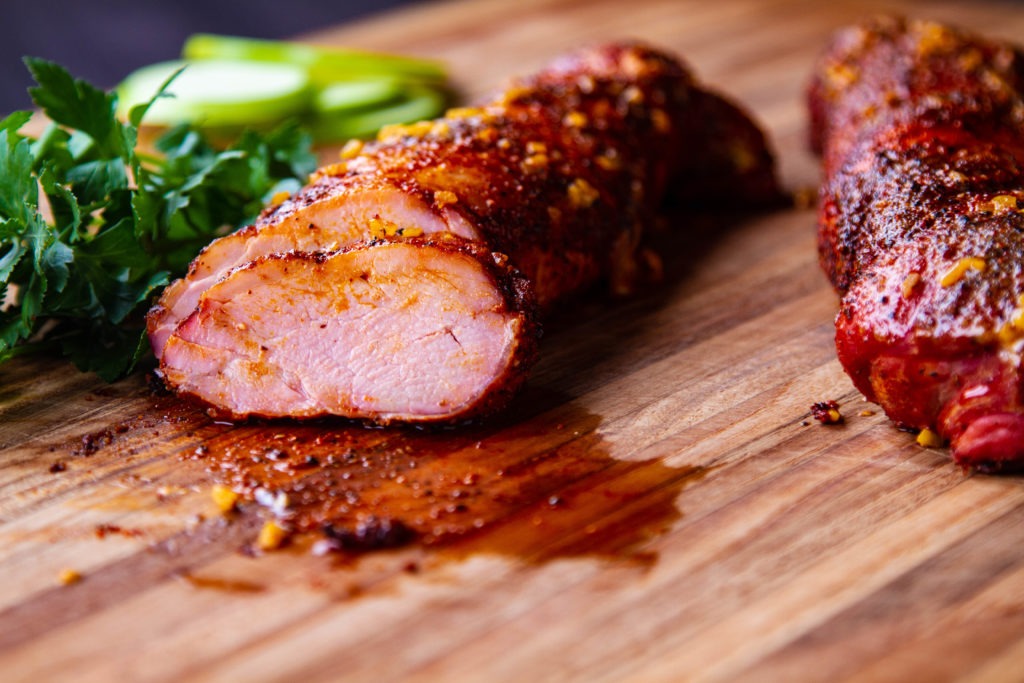There was a real danger to our grandparents’ and grandfathers’ health when they were young that we don’t have to deal with today. No, I’m not talking about the lack of antibiotics, nor the scarcity of nutritious food. It was trichinosis, a parasitic disease that used to be caught from undercooked pork.
The legitimate worry of trichinosis led their mothers to cook their pork until it was very well done. The way they learned to cook it was passed down to their children, and so on until it reached us. The result? We’ve all eaten a lot of too-dry, overcooked pork.
But listen up! The main danger is over, and now we can all enjoy pork as the tasty meat it was always meant to be. With proper temperature control, we can have better pork than our ancestors ever dreamed of. Here, we’ll look at a more nuanced way of thinking about pork temperatures than you’ve likely encountered before.
Pork tenderloin is a lean, quick-cooking cut of meat that’s popular for its tenderness and versatility. When properly cooked, it can be juicy and flavorful. However, it’s not uncommon for pork tenderloin to retain a pink color even when cooked thoroughly to a safe internal temperature. This often leads to the question – how pink can pork tenderloin be and still be safe to eat?
Is Pink Pork Safe?
The USDA recommends cooking pork to a minimum internal temperature of 145°F (62.8°C) to eliminate potential foodborne illnesses. At this temperature, pork can retain a pink tint, especially towards the center of the cut.
As long as the thickest part of the tenderloin registers 145°F on a food thermometer, it is safe to eat. The pink color does not necessarily indicate undercooked pork. Pork cooked to 145°F can be juicy and tender while still reaching the temperature required for safety.
Why Does Safe Pork Stay Pink?
There are a few reasons why properly cooked pork tenderloin may remain pink:
- Cooking method – Quick, high-heat methods like grilling or broiling can sear and brown the exterior while the inside cooks more gently, retaining more pinkness.
- Brining – Soaking pork in a saltwater solution helps it retain moisture and color.
- Smoke – Compounds in wood smoke can react with pigments in the meat, causing it to take on a pink tint.
- Spices and marinades – Ingredients like paprika, curing salts, or vinegar often lend a subtle pinkish hue.
- Low and slow cooking – Slow roasting or cooking indirectly low and slow allows for even, gradual cooking so the interior remains pink.
- Resting – Allowing the pork to rest after cooking enables juices to redistribute, resulting in a pinker interior.
So while color is not always a perfect indicator, temperature offers foolproof doneness confirmation
How Pink is Too Pink?
While some pinkness in pork cooked to 145°F is normal, there is a point where it can indicate undercooking.
Signs pork tenderloin is undercooked:
- Internal temperature under 145°F
- Deep rosy color throughout
- Translucent, glassy appearance
- Raw, glossy texture when cut
- Excess blood is released
These visual indicators mean the pork needs more time to fully cook through to a safe internal temperature. If pork appears this undercooked, it should be returned to heat until the thermometer registers at least 145°F.
Tips for Safely Cooking Pork Tenderloin
- Always begin with fresh, fully thawed tenderloin
- Monitor temperature with an accurate digital instant read thermometer
- Insert thermometer into the thickest part of the meat, away from bone
- Cook until it reaches the minimum safe internal temperature of 145°F
- Allow meat to rest at least 5 minutes before slicing into it
- Double check temperature before serving
How to Tell if Leftover Pork is Safe
When reheating leftover pork tenderloin:
- Verify internal temperature reaches 165°F
- Check for dull, dry, firm texture without redness
- If microwaving, rotate and allow standing time for heat to equalize
- Do not eat pork with an off or sour odor – discard if in doubt
Properly stored, prepared, and cooked pork that is just slightly pink can be enjoyed safely. While color is not always the best indicator, an accurate thermometer reading confirms doneness. Pork tenderloin cooked to 145°F with just a hint of pink can be juicy, flavorful, and safe.

Food safety concerns and thermal thoughts about pork-cooking temperatures
Were they afraid of getting trichinosis, which is what I said before, they cooked their pork too long. But that is a fear that we don’t need to share for two reasons.
First, hog-raising practices have changed and are now mandated to be safer. According to the CDC, “the number of [trichinosis] cases decreased beginning in the middle of the 20th century because of laws that prohibited feeding raw-meat garbage to hogs.” This meant that the trichinella parasite was no longer present in the hogs we eat. In fact, the majority of trichinosis cases now come from undercooked wild animals, not farm-raised pork. (Wild carnivores and omnivores are the main modes of transmission. ).
Second, even if we fear those parasites from our farm-raised hogs, there is a thermal hack to get around them. Freezing cuts of pork that are six inches thick or less to 5°F (-15°C) for 20 days eliminates any trichinella worms that may have somehow gotten into the flesh. Now, 20 days seems like a long time, but when I see a good sale on pork, I tend to stock up, and that pork can easily remain in my freezer for 20 days. When it emerges, it is going to be free of all trichinella, for sure. Well, it will if my freezer goes down to 5°F (-15°C), which I can verify with my ChefAlarm® leave-in probe thermometer.
(Note that the freezing method might not work for wild animals because they can have parasites that don’t die in cold temperatures.) Continue to cook your game well. ).
Once the risk of parasitic infection is taken away, the only risk left is the normal risk of bacterial infection.
Conduct with me, if you will, a thought experiment. Imagine cooking a steak. To what temperature do you cook it? I usually aim for nothing higher than 135°F (57°C). I think you’re happy with the temperature of your steak because you know that it’s safe to eat at that lower temperature.
But think of this: the USDA recommended doneness temp for beef cuts is 145°F (63°C). That’s right, the USDA says you should shy away from anything less than medium-well.
We have put pork on the same level as beef since parasites can no longer live in frozen meat, and I often go against the USDA’s recommendations for beef temperatures. And here’s my own kitchen secret: I also flout them for pork.
You might be shaking your head, your screen, or your trust in my advice right now, but hear me out. Medium-cooked pork loin is delicious. It’s juicy, it’s tender, it has an amazing texture, and it lacks that saw-dusty chewiness of overcooked pork. And some cuts, especially the tenderloin, are even better cooked as low as medium-rare.
Naturally, this option is not for everyone. Yes, technically there is risk. But there is also a risk with every steak. That’s why every steakhouse has that small disclaimer at the bottom of the menu that protects the restaurant from being sued: “eating raw or undercooked potentially hazardous foods may result in foodborne illness.” “Don’t try this if you or someone you care about has a weak immune system or if you should never eat rare or almost-rare meats for safety reasons.”
We think about the pros and cons of every food we eat every day. For this one, the pros are usually greater than the cons.
Pink pork is ok! At least, it can be.
First, let’s get one thing straight: color is not an indicator of doneness, nor of safety. If you put curing salt in a pork loin and brine it, the pork loin will always be pink, no matter how hot you cook it. (That’s basically what Canadian bacon or peameal bacon is. It’s also not safe to eat a well-done pork loin that has been sitting on the table for too long and has been abused by time and temperature after cooking. It’s not pink at all.
If we can’t rely on color to tell us what is safe, what can we use? Temperature! The USDA calls for pork to be cooked to 145°F (63°C) for food safety—much lower than the 160°F (71°C) that many people think is the cutoff for pork—and a quick reading with a Thermapen® ONE can tell us right away if our pork has achieved that safe temperature.
If you cook your meat slowly, so there isn’t much difference in temperature from the outside to the inside, the meat will be much pinker all the way through than if you turn up the heat quickly and “overcook” the outside of the pork while the middle gets close to being done.


PINK PORK Experiment – Is Pink Pork GOOD!?
FAQ
Is it safe to eat medium rare pork tenderloin?
Is pork done at 145 or 160?
Can pork tenderloin be pink on Reddit?
Can pork loin be medium rare?
